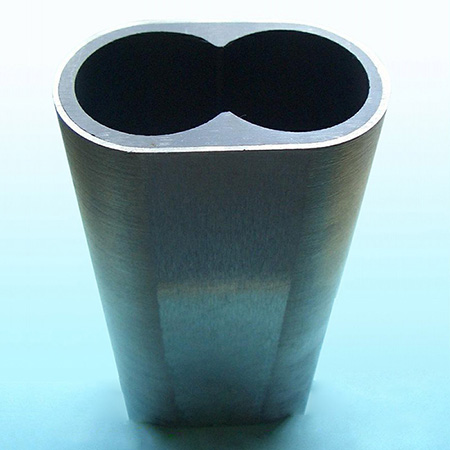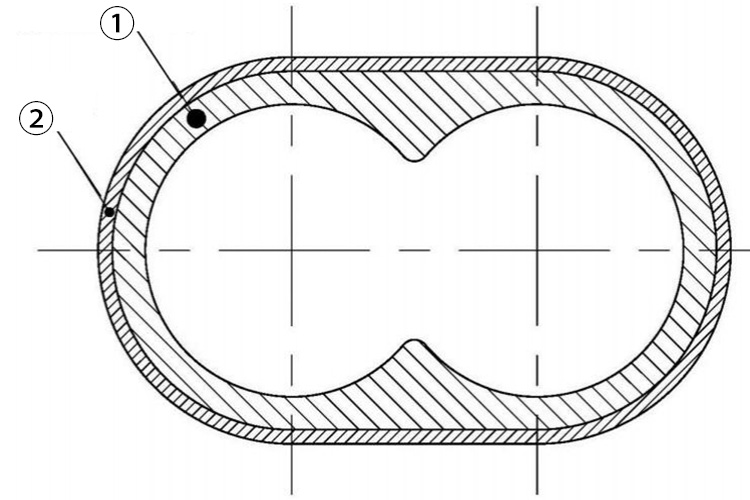- Home
- Technical Support
- Information of C/SiC Composite
With the increasing demand for abrasion-resistence and corrosion-resistence of core parts of extruder, bimetal barrel and screw is not enough for all the circumstances. To process materials with special physical or chemical properties, we researched and developed SiC composite ceramic liners and barrels to be the substitutes of currently widely used bimetal screws and barrels.

Our cost-effective PM-HIP technology and the aluminium alloy clad layer make SiC composite ceramics usable as liners of barrels. This kind of material can surpass almost any other currently used metals in the abrasion-resistance and corrosion-resistance. Even though SiC composite ceramic works with mixture of hydrofluoric acid and nitruc acid (both of them are strong corrosive acid), the thin silica film forming on the surface of the liners can protect SiC from furthur oxidation.
Due to its outstanding performance, SiC composite ceramic oval liner is ideal in harsh operating conditions like the modification and mixing of high loading filling (high loading of inorganic materials in polymer for modification) and high toughness polymetric materials.
Physical and chemical properties of SiC composite ceramic materialMain component, SiC, other additives bring SiC with higher tenacity, so called SiC composite ceramic material.
- Density ( ρ ): 3.08~3.10 g/cm3
- Normal Elastic Modulus ( Ε ): 410 MPa
- Hardness ( HRC ): 89~92
- Buckling Strength ( σbb ) : 380 MPa
- Pressive Strength ( σbc ): 3970 MPa
- Plane Strain Toughness ( Κic ): 4 MPa/mm3/2
- Coefficient of Heat Expansion ( α1 ): 4.0×10-6 / °F
- Thermal Conductivity ( λ ): Φ30~35 W/(m•K)
- Inoxidability under High Temperature:Can be hardly oxidized even at the temperature as high as 1500℃.

① SiC Ceramic Working Layer
② Aluminium Alloy Clad Layer
- An aluminium alloy clad layer can be a buffer layer between the barrel and the SiC ceramic. The coefficient of linear expansion of metal material of the barrel is much higher than that of the SiC ceramic. With the buffer layer, the matal barrel will not put tensile force directly to the SiC ceramic during thermal expansion. Besides, the SiC ceramic is rigid enough to resist the compresive force caused by the metal during thermal contraction. This coating strategy makes the liner very durable and reduce significantly the possibility of crack and deformation.
- Thermal conductivity of the ceramic liner is much higher using the aluminium alloy clad layer.
- Locate screw holes connecting the liner and the barrel are much easier to make.
- The 40% cost of materials and manufacture is saved when we compare our clad liners with the price of pure SiC composite ceramic liner, and this strategy can cut the high proportion of cost of manufacturing in harsh operating condition. Compared with the products of TOYO KOHAN with high price, our product’s price is much lower which is only triple than normal barrel, but our product’s working life is five times than that of normal barrel. With our advanced material processing technologies, our barrels with liners have been working smoothly and showing outstanding performance in Foxconn Group.
- Our SiC composite ceramic oval liner is very easy to replace, so our customers can do it all by themselves.
- Aluminium alloy clading strategy can make it safer for manufacture, transportation and installation of SiC composite ceramic liner.
- Strong designing strength
We design and manufacture the screws, barrels, and extruders according to customer requirements. - Extensive experience
We have been in the extrusion industry for decades, and our products are used by prominent companies such as Foxconn. - Advanced material technologies
Our PM-HIP processing technology increases the material density and reduces casting defects. The new design of an aluminum alloy clad layer on SiC ceramic allows the extruder to work, even in harsh conditions.
We are looking forward to your reply. If you need more information about us or customization information, please do not hesitate to contact us.
- Contact Information
-
Shanghai Omega Machinery Co., Ltd.
Add.: No.168 Hualian Road, Putuo District, Shanghai City
Contact: Williams Wu
Tel.: +86-021-69921527
Fax: +86-021-69921567
E-mail: alphawu@126.com
WeChat: wxsyyk1203wil
-
